You can easily freeze tomato paste. The whole process is simple, doesn’t require any fancy equipment, and takes only a couple of minutes. And best of all, defrosted tomato paste is as good as fresh.
I’m sure you’re familiar with this. You buy a can of tomato paste, use a tablespoon or two in a recipe, and place the leftovers in the fridge. Next time you see that can, there’s a layer of fuzzy mold on the paste. Not good.
Freezing leftover tomato paste is an easy solution to tomato paste waste. Plus, the concentrate has a pretty low moisture content, so it freezes well.
In other words, there are no downsides to freezing leftover tomato paste, besides the fact that you need to spend an extra five minutes taking care of it.
In this article, I cover:
- how to freeze tomato paste (including some tips)
- defrosting the paste (and some photos of how thawed tomato paste looks like)
- using frozen and defrosted tomato paste
Interested? Let’s dive in.
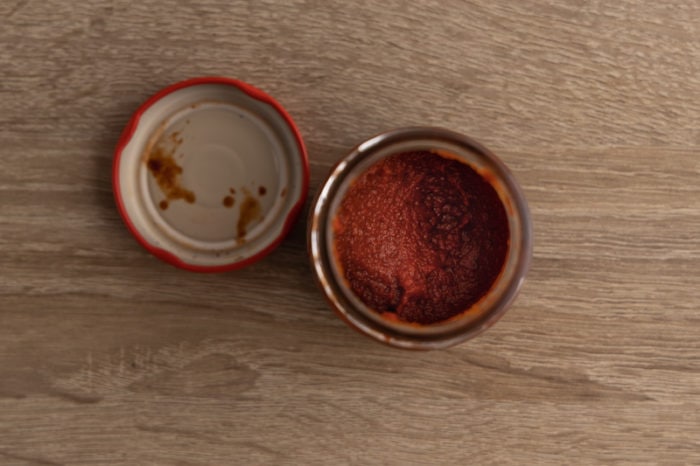
How To Freeze Tomato Paste
Here’s how you freeze tomato paste:
- Prep. Grab a cookie sheet or a plate, and line it with plastic wrap or something similar (I use a silicone mat). If you skip lining the surface, the tomato paste will stick to it, and removing it might be a bit more difficult, but still possible.
- Portion the paste. Grab a teaspoon and drop dollops of tomato paste on the prepped surface. Try to make them uniform if possible (or use a measuring spoon instead). When it comes to dollop size, go with what works best for what you cook. Or keep it simple and go with 1-teaspoon ones. You can always use a couple of them if you need more for a recipe. Make sure the dollops don’t touch.

Tomato paste dollops before freezing - Pre-freeze. Place the tray in the freezer and leave it there for at least 3 to 4 hours, or overnight. Make sure the blobs are frozen solid before you proceed.
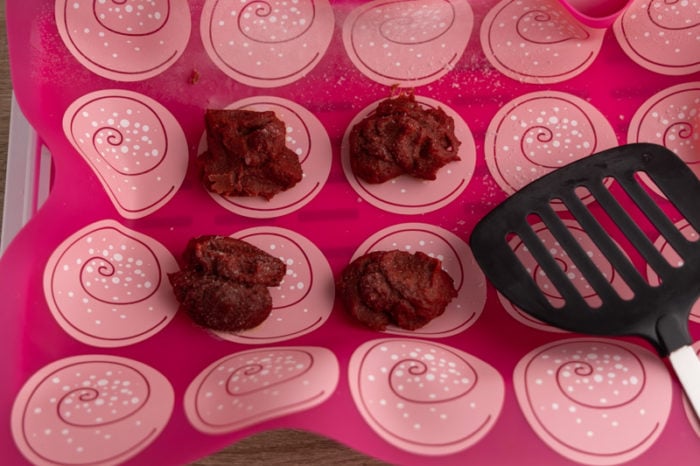
Frozen tomato paste dollops. Ready for transferring into a bag. - Transfer frozen dollops into a freezer bag. Your fingers will melt the surface of the blobs almost immediately, so use a spatula to transfer them instead. Squeeze the air out of the bag, and seal it. Add a label if you like.
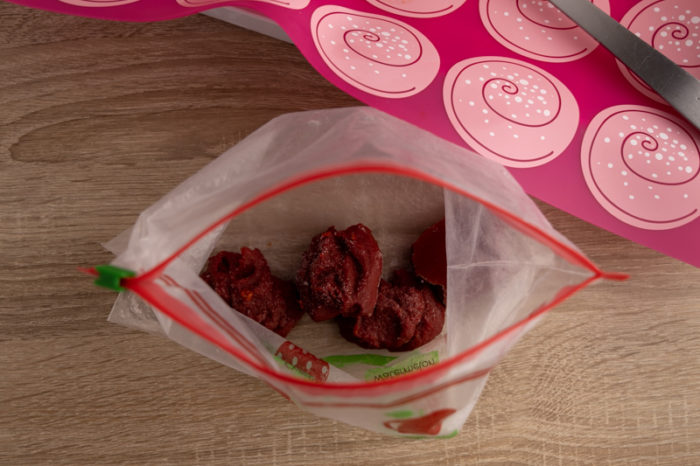
Frozen tomato paste blobs in a freezer bag - Freeze. Place the bag with the frozen blobs of tomato paste in the freezer.
That’s it. Your tomato paste dollops are ready to be frozen for the long term.
If you’re not quite fond of the free-form dollops approach, feel free to use an ice cube tray instead. It might require a bit more hands-on time (removing the cubes can be tricky), but you end up with the same-sized cubes.
Now that the tomato paste is frozen, you might be wondering how long it can sit in the freezer. Let’s tackle that.
How Long Can You Freeze Tomato Paste?
Tomato paste can sit in the freezer for at least six months without significant quality loss. Possibly even longer.
It’s pretty low in moisture, and it freezes well, so there’s no reason why it should quickly lose quality in the freezer.
As usual, the sooner you eat the blobs, the better the quality, but there’s no rush here.
Take your time, and feel free to add another batch of frozen lumps into the same bag if you freeze leftovers from another jar or can.
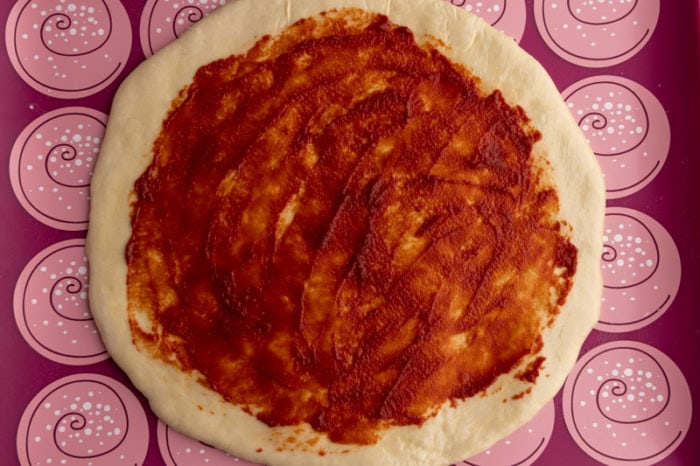
Ways to Defrost Tomato Paste
There are two ways you can go about defrosting tomato paste. Choose one that fits your circumstances best.
Defrost in the Fridge
A typical 1-teaspoon blob of tomato paste needs 1 to 2 hours in the fridge to fully defrost. If you went with larger lumps, adjust the defrosting time accordingly.
When defrosting in the refrigerator, I suggest placing the dollop or cube on a plate or in an airtight container. It’s much easier to wash either of them (or you can use a dishwasher) than to wipe a freezer bag clean from tomato paste.
Defrosting is pretty much a must if you need the paste spreadable before using it (e.g., when making a simple pizza sauce, such as this one).
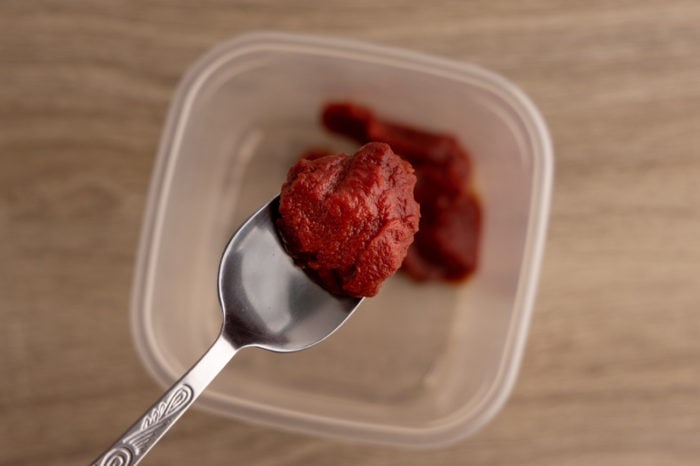
Skip Thawing
Many dishes that call for tomato paste are cooked on the stove (like tomato soup or chili).
If that’s the case, you can usually skip defrosting and just throw in that dollop or two of frozen tomato paste right in. A few minutes on the stove and a bit of stirring will thaw the whole thing and incorporate the paste with the rest of the ingredients.
As a bonus, you don’t have to remember about taking the blobs from the freezer ahead of time if you don’t defrost them.
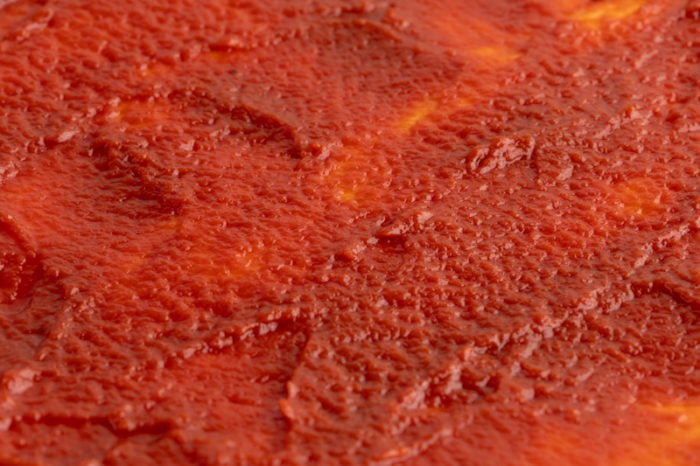
Using Tomato Paste
As I already said in the intro, tomato paste freezes perfectly fine. And because of that, you can use it exactly the same way you use fresh tomato paste.
That means all sorts of sauces, casseroles, chillis, and soups are all on the table.